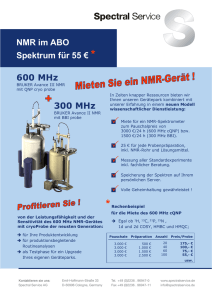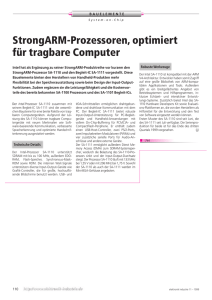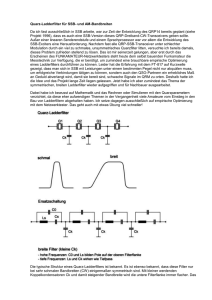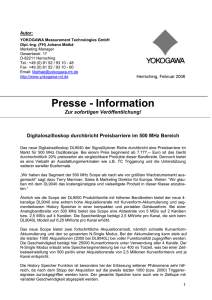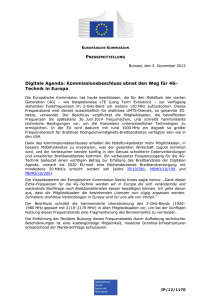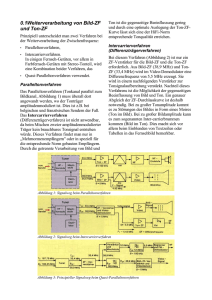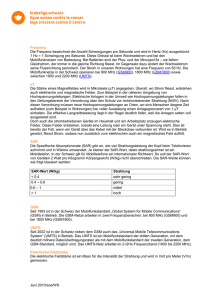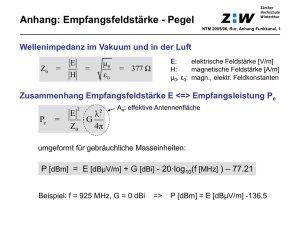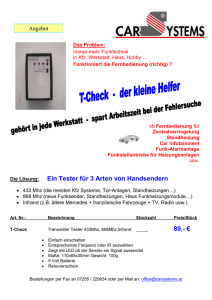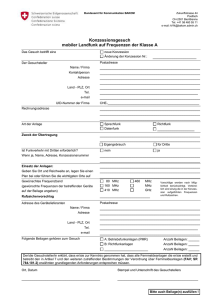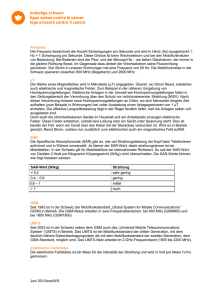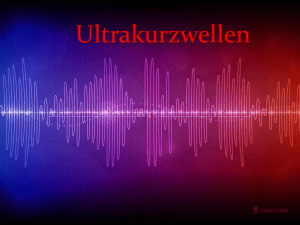Datenblatt
Werbung
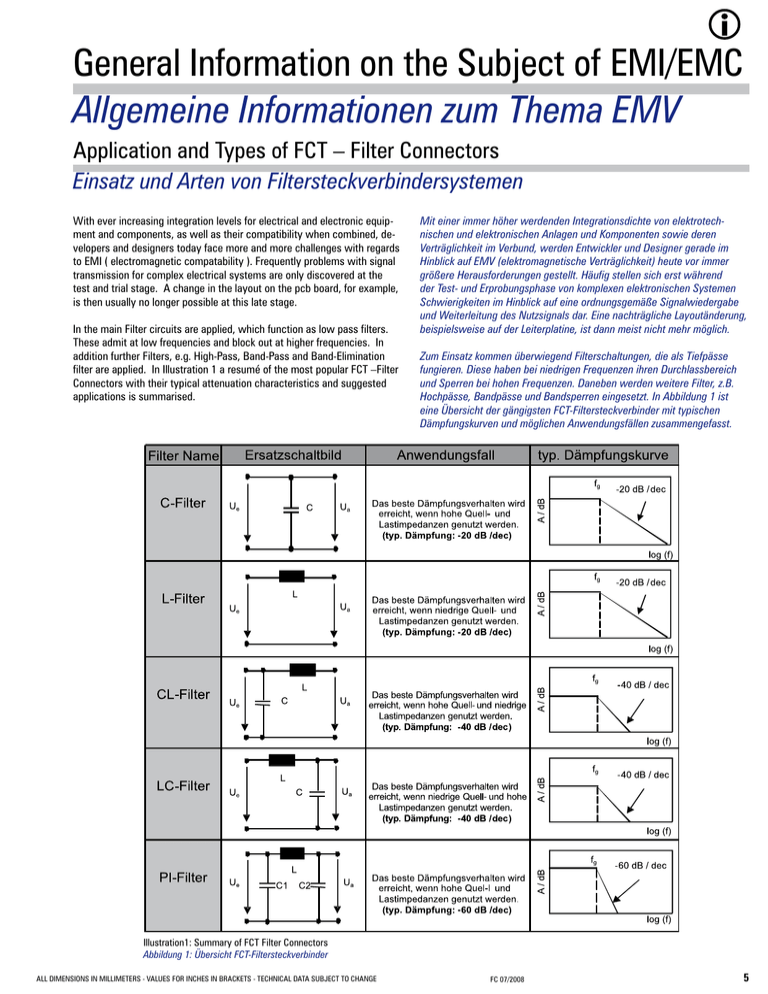
General Information on the Subject of EMI/EMC Allgemeine Informationen zum Thema EMV Application and Types of FCT – Filter Connectors Einsatz und Arten von Filtersteckverbindersystemen With ever increasing integration levels for electrical and electronic equipment and components, as well as their compatibility when combined, developers and designers today face more and more challenges with regards to EMI ( electromagnetic compatability ). Frequently problems with signal transmission for complex electrical systems are only discovered at the test and trial stage. A change in the layout on the pcb board, for example, is then usually no longer possible at this late stage. In the main Filter circuits are applied, which function as low pass filters. These admit at low frequencies and block out at higher frequencies. In addition further Filters, e.g. High-Pass, Band-Pass and Band-Elimination filter are applied. In Illustration 1 a resumé of the most popular FCT –Filter Connectors with their typical attenuation characteristics and suggested applications is summarised. Mit einer immer höher werdenden Integrationsdichte von elektrotechnischen und elektronischen Anlagen und Komponenten sowie deren Verträglichkeit im Verbund, werden Entwickler und Designer gerade im Hinblick auf EMV (elektromagnetische Verträglichkeit) heute vor immer größere Herausforderungen gestellt. Häufig stellen sich erst während der Test- und Erprobungsphase von komplexen elektronischen Systemen Schwierigkeiten im Hinblick auf eine ordnungsgemäße Signalwiedergabe und Weiterleitung des Nutzsignals dar. Eine nachträgliche Layoutänderung, beispielsweise auf der Leiterplatine, ist dann meist nicht mehr möglich. Zum Einsatz kommen überwiegend Filterschaltungen, die als Tiefpässe fungieren. Diese haben bei niedrigen Frequenzen ihren Durchlassbereich und Sperren bei hohen Frequenzen. Daneben werden weitere Filter, z.B. Hochpässe, Bandpässe und Bandsperren eingesetzt. In Abbildung 1 ist eine Übersicht der gängigsten FCT-Filtersteckverbinder mit typischen Dämpfungskurven und möglichen Anwendungsfällen zusammengefasst. Illustration1: Summary of FCT Filter Connectors Abbildung 1: Übersicht FCT-Filtersteckverbinder ALL DIMENSIONS IN MILLIMETERS - VALUES FOR INCHES IN BRACKETS - TECHNICAL DATA SUBJECT TO CHANGE FC 07/2008 Application and Types of FCT – Filter Connectors Einsatz und Arten von Filtersteckverbindersystemen The application of different filter types depends upon the requirements of the circuit which need filtering. The Filter type is designated according to the Source and Load impedance as well as the attenuation characteristics. The critical frequency fg describes the transition between the pass and hold-in range of the filter. With the critical frequency fg the amplitude of the transmitted signal is smaller than the direct current voltage by a factor of ~ 0,7. This means that the amplification is -3 dB lower , or that the attenuation has a value of 3 dB. Low-Pass and High-pass have one critical frequency , Band-Pass and Band-Elimination filter both have two critical frequencies each. In Illustration 2 the principle attenuation shape for the amplitude-frequency response of a Low-Pass are displayed. Der Einsatz der unterschiedlichen Filtertypen richtet sich nach den Anforderungen der zu befilternden Schaltung. Der Filtertyp wird nach den Quellund Lastimpedanzen sowie den Dämpfungscharakteristiken bestimmt. Die Grenzfrequenz fg beschreibt den Übergang zwischen Durchlass- und Sperrbereich des Filters. Bei der Grenzfrequenz fg ist die Amplitude des übertragenen Signals um den Faktor ~ 0,7 kleiner als bei Gleichspannung. Das bedeutet, dass das Verstärkungsmaß um -3 dB fällt, oder das Dämpfungsmaß den Wert 3 dB hat. Tiefpaß und Hochpaß haben eine Grenzfrequenz, Bandpaß und Bandsperre jeweils zwei Grenzfrequenzen. In Abbildung 2 sind die prinzipiellen Dämpfungsverläufe des Amplituden-Frequenzgangs für einen Tiefpaß dargestellt. Illustration 2 : Block-diagrams , principle attenuation line and attenuation measurement for a Low-Pass Abbildung 2: Blockschaltbild, Prinzipieller Dämpfungsverlauf und Dämpfungsmaß eines Tiefpasses FC 07/2008 TECHNISCHE ÄNDERUNGEN VORBEHALTEN – MAßE IN MILLIMETER (INCHES IN KLAMMERN) Technical Advice Technische Hinweise In the near field, electrical (E; caused by voltage) and magnetic fields (H, caused by current) are to be examined separately. In the distant field however, (d > λ / 2π or d > 48 MHz x m / f [e.g. 300 MHz ⇒ λ = 1 m ⇒ d > 0,16 m]) both fields are coupled by the wave resistance Z = E / H (= 377 Ω in the air). The more the wave resistance of the shielding material deviates from 377 Ω , the more effective the shielding through reflection will be (ru = (Za - Zi ) / (Za + Zi )). Im Nahfeld sind elektrisches (E; durch Spannung hervorgerufen) und magnetisches Feld (H; durch Strom erzeugt) getrennt zu betrachten. Dagegen sind im Fernfeld (d > λ / 2π bzw. d > 48 MHz x m / f [z.B. 300 MHz ⇒ λ = 1 m ⇒ d > 0,16 m]) beide Felder fest über den Wellenwiderstand Z = E / H (= 377 Ω in der Luft) gekoppelt. Die Effektivität der Abschirmung durch Reflexion ist umso besser, je mehr der Wellenwiderstand des Abschirmmaterials von 377 Ω abweicht (ru = (Za - Zi ) / (Za + Zi )). Frequently one finds information given in dB, which is nothing more than a correlation of two figures (see table). For example, if attenuation were discussed without any further reference or with the index dBm, then the attenuation is always being discussed in relation to power. Should a correlation with power not be meant, then an appropriate index will be given e.g. dBµV. Häufig findet man Angaben in dB, die ohne weiteren Zusatz nichts anderes als ein Verhältnis zweier Zahlen bedeuten (siehe Tabelle). Handelt es sich z.B. um eine Dämpfung ohne weiteren Bezug oder mit der Angabe dBm, so ist es immer ein auf die Leistung bezogener Wert. Sind einmal nicht Leistungen gemeint, so wird ein entsprechender Index angehängt z.B. dBµV. Examples for the Application of Filter Connectors (Calculation) Beispiel für den Einsatz von Filtersteckern (Berechnung) Input Power Attentuation Output Power Input Power Attenuation Output Power Eingangsleistung Dämpfung Ausgangsleistung Eingangsleistung Dämpfung Ausgangsleistung 100% -10 dB 10% 100% -70 dB 0,1 ppm 100% -20 dB 1% 100% -80 dB 0,01 ppm 100% -30 dB 0,1% 100% -90 dB 0,001 ppm 100% -40 dB 0,01% 100% -100 dB 0,000.1 ppm 100% -50 dB 0,001% 100% -110 dB 0,000.01 ppm 100% -60 dB 0,000.1% 100% -120 dB 0,000.001 ppm Filter Filter 3 dB Cut-off Frequency 10 dB Cut-off Frequency 3 dB Cut-off Frequency in 10 dB Cut-off Frequency in in a 50 Ω Line for in a 50 Ω Line for a 75 Ω Line for Wanted a 75 Ω Line for Spurious Wanted Signal Spurious Signal Signal Signal 3 dB Grenzfrequenz im 50 Ω System für Nutzsignale 10 dB Grenzfrequenz im 50 Ω System für Störsignale 3 dB Grenzfrequenz im 75 Ω System für Nutzsignale 10 dB Grenzfrequenz im 75 Ω System für Störsignale C-Filter 47 pF 135,5 MHz 406,4 MHz 90,3 MHz 270,9 MHz C-Filter 1 nF 6,4 MHz 19,1MHz 4,2 MHz 12,7 MHz C-Filter 2 nF 3,2 MHz 9,6 MHz 2,1 MHz 6,6 MHz Filter 2 * 1 nF, 1 * 100 nH 2,2 MHz 8,9 MHz 1,5 MHz 6,0 MHz L-Filter 100 nH 4,5 MHz 50,3 MHz 6,8 MHz 75,4 MHz ALL DIMENSIONS IN MILLIMETERS - VALUES FOR INCHES IN BRACKETS - TECHNICAL DATA SUBJECT TO CHANGE FC 07/2008
